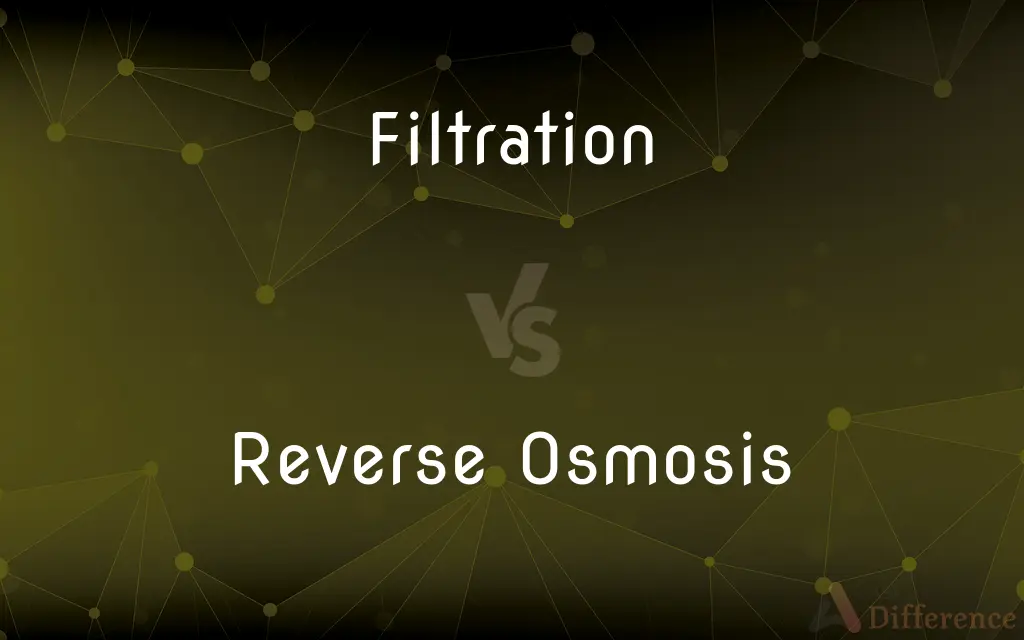Filtration vs. Reverse Osmosis — What's the Difference?
Edited by Tayyaba Rehman — By Fiza Rafique — Published on December 13, 2023
Filtration separates particles from a liquid using a barrier. Reverse Osmosis forces water through a membrane, removing even smaller impurities.

Difference Between Filtration and Reverse Osmosis
Table of Contents
ADVERTISEMENT
Key Differences
Filtration is a process where solids are separated from liquids or gases using a porous barrier or medium. Reverse Osmosis, on the other hand, is a specialized form of filtration where water is pushed through a semi-permeable membrane to remove finer impurities.
While Filtration can effectively remove larger particles, such as sand or silt, from water, it may not effectively eliminate dissolved salts or smaller contaminants. Reverse Osmosis, however, is known for its ability to remove dissolved solids and even some bacteria and viruses.
Filtration methods can be varied, utilizing materials like cloth, paper, or ceramic filters. In contrast, Reverse Osmosis specifically requires a thin-film composite membrane, designed to allow only water molecules to pass through.
Filtration is commonly used in various industries and household applications for cleaning water and air. Reverse Osmosis, while also used in industries, is especially popular for producing purified drinking water due to its high efficacy.
Energy consumption varies between the two. Filtration usually requires less energy, relying mainly on gravity or minimal pressure. Reverse Osmosis demands higher pressures, hence higher energy, to push water through its selective membrane.
ADVERTISEMENT
Comparison Chart
Primary Mechanism
Uses a barrier to separate particles.
Uses a semi-permeable membrane to filter impurities.
Efficacy
Removes larger particles.
Removes even dissolved solids and microorganisms.
Typical Materials Used
Cloth, paper, ceramic filters.
Thin-film composite membrane.
Common Applications
Industrial processes, water and air cleaning.
Drinking water purification, desalination.
Energy Consumption
Generally lower.
Higher due to need for increased pressure.
Compare with Definitions
Filtration
Filtration is the process of separating solids from liquids or gases.
The coffee-making process uses Filtration to separate grounds from the liquid.
Reverse Osmosis
Reverse Osmosis is a water purification technique.
Reverse Osmosis systems produce clean drinking water in many homes.
Filtration
Filtration employs a barrier or medium to trap particles.
Filtration through a cloth removed the debris from the water.
Reverse Osmosis
Reverse Osmosis forces water through a selective membrane.
The plant uses Reverse Osmosis to desalinate seawater.
Filtration
Filtration can be used in air purification.
The air purifier's Filtration system captured dust and pollen particles.
Reverse Osmosis
Reverse Osmosis is effective in producing distilled-quality water.
For their experiments, scientists used water purified by Reverse Osmosis.
Filtration
Filtration can be gravitational or pressure-driven.
The aquarium uses gravitational Filtration to keep the water clear.
Reverse Osmosis
Reverse Osmosis can remove dissolved salts and microorganisms.
To reduce water hardness, the company installed a Reverse Osmosis unit.
Filtration
Filtration aids in clarifying solutions.
Wine undergoes Filtration to remove sediments.
Reverse Osmosis
Reverse Osmosis operates under high pressure.
The pump provides the necessary pressure for the Reverse Osmosis process.
Filtration
The act or process of filtering.
Filtration
The act or process of filtering; the mechanical separation of a liquid from the undissolved particles floating in it.
Filtration
A totally ordered collection of subsets.
Filtration
The act or process of filtering; the mechanical separation of a liquid from the undissolved particles floating in it.
Filtration
The process whereby fluids pass through a filter or a filtering medium
Filtration
The act of changing a fluid by passing it through a filter
Common Curiosities
Can Filtration remove dissolved salts?
Typical Filtration can't remove dissolved salts, but Reverse Osmosis can.
Does Filtration always require external pressure?
No, Filtration can be gravitational or pressure-driven, depending on the application.
How does Reverse Osmosis differ from Filtration?
Reverse Osmosis is a specialized filtration method that uses a semi-permeable membrane to remove finer contaminants from water.
What contaminants can Reverse Osmosis remove?
Reverse Osmosis can remove dissolved solids, bacteria, viruses, and certain chemicals from water.
Why is Reverse Osmosis popular for drinking water?
Reverse Osmosis effectively removes a wide range of contaminants, making water purer and safer for consumption.
Can Filtration be used for air purification?
Yes, Filtration is commonly used in air purifiers to trap airborne particles.
Which process consumes more energy - Filtration or Reverse Osmosis?
Reverse Osmosis generally consumes more energy due to the high pressures required.
What is Filtration?
Filtration is a process that separates solids from liquids or gases using a barrier or medium.
Do all homes need a Reverse Osmosis system?
No, but homes with water quality concerns or those wanting purer water may benefit from Reverse Osmosis systems.
How does Reverse Osmosis help in desalination?
Reverse Osmosis can remove the salts from seawater, making it suitable for drinking and agriculture.
What are the common uses of Filtration?
Filtration is commonly used in drinking water treatment, wastewater treatment, air purification, and various industrial processes.
Can both Filtration and Reverse Osmosis be used together?
Yes, many water treatment systems use Filtration followed by Reverse Osmosis for comprehensive purification.
What materials are used in Reverse Osmosis membranes?
Typically, thin-film composite materials are used in Reverse Osmosis membranes.
Can Filtration remove bacteria?
Some high-quality Filtration systems can trap bacteria, but Reverse Osmosis is more effective for this purpose.
Are there environmental concerns with Reverse Osmosis?
Yes, Reverse Osmosis can produce wastewater, and energy consumption can also be an environmental concern.
Share Your Discovery

Previous Comparison
Education vs. Socialization
Next Comparison
Learning Curve vs. Experience CurveAuthor Spotlight
Written by
Fiza RafiqueFiza Rafique is a skilled content writer at AskDifference.com, where she meticulously refines and enhances written pieces. Drawing from her vast editorial expertise, Fiza ensures clarity, accuracy, and precision in every article. Passionate about language, she continually seeks to elevate the quality of content for readers worldwide.
Edited by
Tayyaba RehmanTayyaba Rehman is a distinguished writer, currently serving as a primary contributor to askdifference.com. As a researcher in semantics and etymology, Tayyaba's passion for the complexity of languages and their distinctions has found a perfect home on the platform. Tayyaba delves into the intricacies of language, distinguishing between commonly confused words and phrases, thereby providing clarity for readers worldwide.












































